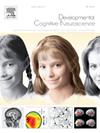测量和解释胎儿、婴儿和幼儿神经发育的个体差异
IF 4.9
2区 医学
Q1 NEUROSCIENCES
引用次数: 0
摘要
作为对胎儿、婴儿和幼儿(FIT)神经发育感兴趣的科学家,我们的研究问题通常集中在个体儿童在神经发育方面的差异以及这些个体差异对长期神经和行为结果的预测价值。测量和解释神经发育的个体差异可能会带来挑战:人类大脑发育是否存在“标准”方式?我们在研究“发展”时所受的语义、实践或理论限制如何影响我们衡量和解释个体差异的方式?虽然在整个生命周期中考虑这些问题很重要,但它们对于进行和解释胎儿、婴儿和幼儿神经发育的个体差异研究尤其重要,因为在这一时期发生了快速、深刻和异质的变化,这可能是长期结果的预测。因此,本文有三个目标:1)概述如何在发育认知神经科学领域研究神经发育的个体差异;2)确定研究神经发育个体差异时的挑战和注意事项;3)讨论潜在的影响和解决方案。本文章由计算机程序翻译,如有差异,请以英文原文为准。
Measuring and interpreting individual differences in fetal, infant, and toddler neurodevelopment
As scientists interested in fetal, infant, and toddler (FIT) neurodevelopment, our research questions often focus on how individual children differ in their neurodevelopment and the predictive value of those individual differences for long-term neural and behavioral outcomes. Measuring and interpreting individual differences in neurodevelopment can present challenges: Is there a “standard” way for the human brain to develop? How do the semantic, practical, or theoretical constraints that we place on studying “development” influence how we measure and interpret individual differences? While it is important to consider these questions across the lifespan, they are particularly relevant for conducting and interpreting research on individual differences in fetal, infant, and toddler neurodevelopment due to the rapid, profound, and heterogeneous changes happening during this period, which may be predictive of long-term outcomes. This article, therefore, has three goals: 1) to provide an overview about how individual differences in neurodevelopment are studied in the field of developmental cognitive neuroscience, 2) to identify challenges and considerations when studying individual differences in neurodevelopment, and 3) to discuss potential implications and solutions moving forward.
求助全文
通过发布文献求助,成功后即可免费获取论文全文。
去求助
来源期刊

Developmental Cognitive Neuroscience
NEUROSCIENCES-
CiteScore
7.60
自引率
10.60%
发文量
124
审稿时长
6-12 weeks
期刊介绍:
The journal publishes theoretical and research papers on cognitive brain development, from infancy through childhood and adolescence and into adulthood. It covers neurocognitive development and neurocognitive processing in both typical and atypical development, including social and affective aspects. Appropriate methodologies for the journal include, but are not limited to, functional neuroimaging (fMRI and MEG), electrophysiology (EEG and ERP), NIRS and transcranial magnetic stimulation, as well as other basic neuroscience approaches using cellular and animal models that directly address cognitive brain development, patient studies, case studies, post-mortem studies and pharmacological studies.
 求助内容:
求助内容: 应助结果提醒方式:
应助结果提醒方式:


